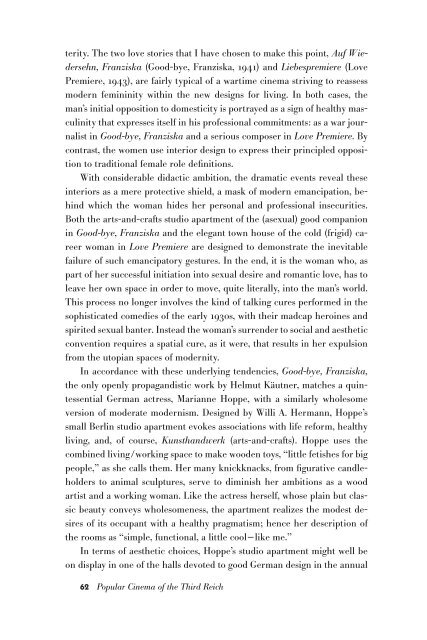Create successful ePaper yourself
Turn your PDF publications into a flip-book with our unique Google optimized e-Paper software.
terity. The two love stories that I have chosen to make this point, Auf Wiedersehn,<br />
Franziska (Good-bye, Franziska, 1941) and Liebespremiere (Love<br />
Premiere, 1943), are fairly typical of a wartime cinema striving to reassess<br />
modern femininity within the new designs for living. In both cases, the<br />
man’s initial opposition to domesticity is portrayed as a sign of healthy masculinity<br />
that expresses itself in his professional commitments: as a war journalist<br />
in Good-bye, Franziska and a serious composer in Love Premiere. By<br />
contrast, the women use interior design to express their principled opposition<br />
to traditional female role definitions.<br />
With considerable didactic ambition, the dramatic events reveal these<br />
interiors as a mere protective shield, a mask of modern emancipation, behind<br />
which the woman hides her personal and professional insecurities.<br />
Both the arts-and-crafts studio apartment of the (asexual) good companion<br />
in Good-bye, Franziska and the elegant town house of the cold (frigid) career<br />
woman in Love Premiere are designed to demonstrate the inevitable<br />
failure of such emancipatory gestures. In the end, it is the woman who, as<br />
part of her successful initiation into sexual desire and romantic love, has to<br />
leave her own space in order to move, quite literally, into the man’s world.<br />
This process no longer involves the kind of talking cures performed in the<br />
sophisticated comedies of the early 1930s, with their madcap heroines and<br />
spirited sexual banter. Instead the woman’s surrender to social and aesthetic<br />
convention requires a spatial cure, as it were, that results in her expulsion<br />
from the utopian spaces of modernity.<br />
In accordance with these underlying tendencies, Good-bye, Franziska,<br />
the only openly propagandistic work by Helmut Käutner, matches a quintessential<br />
German actress, Marianne Hoppe, with a similarly wholesome<br />
version of moderate modernism. Designed by Willi A. Hermann, Hoppe’s<br />
small Berlin studio apartment evokes associations with life reform, healthy<br />
living, and, of course, Kunsthandwerk (arts-and-crafts). Hoppe uses the<br />
combined living/working space to make wooden toys, “little fetishes for big<br />
people,” as she calls them. Her many knickknacks, from figurative candleholders<br />
to animal sculptures, serve to diminish her ambitions as a wood<br />
artist and a working woman. Like the actress herself, whose plain but classic<br />
beauty conveys wholesomeness, the apartment realizes the modest desires<br />
of its occupant with a healthy pragmatism; hence her description of<br />
the rooms as “simple, functional, a little cool—like me.”<br />
In terms of aesthetic choices, Hoppe’s studio apartment might well be<br />
on display in one of the halls devoted to good German design in the annual<br />
62 Popular Cinema of the Third Reich

















